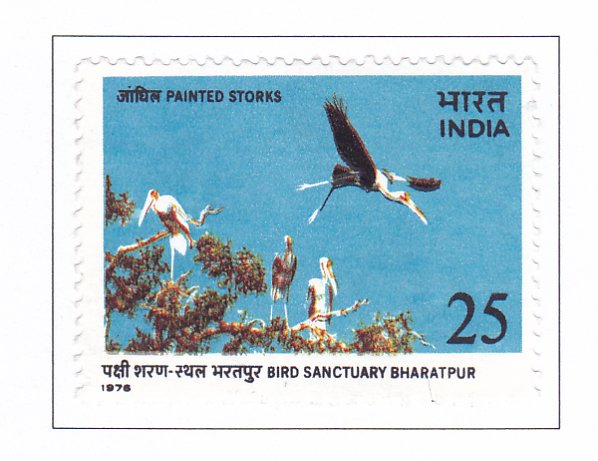Keoladeo Ghana Bird Sanctuary, Bharatpur

Technical Data
| Stamp Set | Birds |
|---|---|
| Date of Issue | February 10, 1976 |
| Denomination | 25 p |
| Quantity | 3,000,000 |
| Perforation | comb 13 |
| Printer | Security Printing Press, Nashik |
| Watermark | No Watermark |
| Colors | Multicolor |
| Catalog Codes |
Michel IN 667 Stamp Number IN 713 Yvert et Tellier IN 471 Stanley Gibbons IN 800 |
| Themes | Animals (Fauna) | Birds | Storks | UNESCO World Heritage Sites |
The Keoladeo Ghana Bird Sanctuary, located in Bharatpur, Rajasthan, is renowned as one of the most remarkable water-bird sanctuaries globally, offering a breathtaking display of indigenous breeding birds and winter migrants. The sanctuary’s subtropical climate, along with its extensive aquatic vegetation and abundance of trees, creates ideal conditions for nesting.
Following the southwest monsoon, Indian water-birds such as cormorants, darters (snake-birds), spoonbills, white ibises, egrets, grey herons, painted storks, and open-billed storks begin nesting, typically in congested, mixed colonies on trees partly submerged in water. These nesting colonies are primarily located in the numerous acacia (babul) trees scattered throughout the marshland. By the arrival of the northeast monsoon and winter, these birds have usually raised multiple broods and completed their strenuous breeding efforts, allowing them to freely fly to nearby or distant feeding grounds.
During winter, migratory birds from regions as far as Russia (Siberia) and northern Europe arrive in Ghana by November. The magnificent Siberian crane, along with various ducks, geese, sandpipers, plovers, and other species, descend in vast numbers on the large, shallow water bodies in the sanctuary, spending a few months feeding before returning to their northern homes by the end of February. Additionally, some indigenous water-birds that have finished breeding elsewhere in India also migrate to the sanctuary.
For example, among the three kinds of pelicans found in the sanctuary, two are migrants from outside the country, while the third, the grey pelican, breeds in India itself. Indigenous birds typically begin their nesting activities by mid-September and depart by March.
Given the sanctuary’s wide range and large numbers of water-birds, the esteemed National Audubon Society of the United States has chosen it to host its Ecology Workshop from February 9 to 11, 1976. In honor of this occasion, the Posts & Telegraphs Department is pleased to release a special postage stamp featuring the Keoladeo Ghana Bird Sanctuary in Bharatpur.
